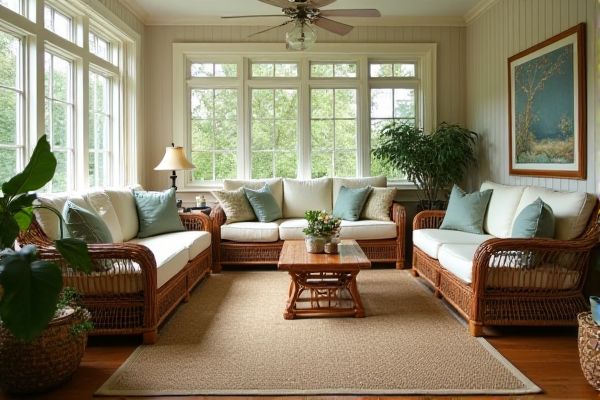
Wicker furniture offers a versatile design made from weaving natural or synthetic materials, while rattan furniture specifically uses the durable and lightweight rattan vine, making it ideal for sunrooms with a natural look. Discover the key differences and find out which option best suits Your sunroom by reading the full article.
Table of Comparison
| Feature | Wicker Furniture | Rattan Furniture |
|---|---|---|
| Material | Natural fibers or synthetic resin woven | Natural rattan vine, solid or peeled |
| Durability | Moderate; synthetic variants weather-resistant | High; strong and flexible but sensitive to moisture |
| Maintenance | Low to medium; requires dusting and occasional cleaning | Medium; needs regular dusting and protection from humidity |
| Appearance | Varied textures and colors; classic woven look | Natural, smooth finish with visible grains |
| Weight | Light to medium | Lightweight and easy to move |
| Suitability for Sunroom | Ideal with synthetic wicker for sunroom use | Good if kept dry; best used in covered sunrooms |
| Cost | Affordable to mid-range | Mid-range to premium |
Understanding Wicker and Rattan: Key Differences
Wicker refers to the weaving technique used to create furniture, typically involving synthetic or natural materials, while rattan is a specific type of vine often used as the core material in wicker furniture. Rattan furniture is lightweight, durable, and flexible, making it ideal for sunrooms where natural light enhances its warm, natural aesthetic. Your choice between wicker and rattan should consider durability, maintenance, and the overall style you want to achieve in your sunroom space.
Materials Used in Wicker vs Rattan Furniture
Wicker furniture typically refers to pieces woven from various natural or synthetic materials such as willow, reed, bamboo, or resin fibers, offering durability for sunroom environments. Rattan furniture specifically uses the rattan vine, a strong and flexible material known for its lightweight yet sturdy qualities, making it ideal for indoor and outdoor sunroom settings. The distinction lies in wicker's weaving technique applied to diverse materials, whereas rattan furniture harnesses the natural rattan core for frame construction and weaving.
Durability and Longevity in Sunroom Environments
Wicker furniture, typically made from synthetic materials like resin, offers exceptional durability and resistance to moisture, making it ideal for sunroom environments prone to humidity and sunlight exposure. Rattan furniture, crafted from natural vine material, provides a lightweight and stylish option but requires more care to prevent wear from UV rays and moisture. You can expect wicker furniture to maintain its integrity and appearance longer in a sunroom, while rattan may need periodic treatment to extend its longevity.
Style and Aesthetic Appeal: Wicker vs Rattan
Wicker and rattan furniture both enhance your sunroom with unique style and aesthetic appeal, but they differ significantly in texture and appearance. Wicker refers to the weaving technique used, often incorporating various materials like synthetic fibers, which allows for diverse patterns and colors, adding a modern or rustic charm. Rattan, a natural vine material, presents a warm, organic look featuring smooth, sturdy frames and a natural finish that brings an inviting, tropical vibe ideal for sunroom settings.
Comfort Level: Which Furniture Offers More Relaxation?
Wicker furniture, often crafted from synthetic materials, provides a lightweight and flexible seating experience with cushioned options that enhance comfort in sunrooms. Rattan furniture, derived from natural vine species, offers a sturdier, more supportive structure that molds well to body contours, promoting relaxation through ergonomic design. The choice between wicker and rattan furniture for sunroom comfort depends on desired softness and durability, with rattan generally preferred for long-term relaxation and wicker favored for its versatility and ease of maintenance.
Maintenance and Cleaning Requirements
Wicker furniture, typically made from synthetic fibers, is highly resistant to moisture and UV rays, making it easier to clean with just mild soap and water, ideal for your sunroom's low-maintenance needs. Rattan furniture, crafted from natural plant fibers, requires more delicate care, including regular dusting and occasional application of a protective sealant to prevent drying and cracking. Understanding these maintenance differences ensures your sunroom setup stays attractive and durable over time.
Cost Comparison: Wicker vs Rattan Sunroom Furniture
Wicker sunroom furniture typically costs less than rattan due to its synthetic materials and mass production methods, offering affordable options for your space. Rattan furniture, made from natural vine fibers, tends to be pricier because of its handwoven craftsmanship and durability, making it a long-term investment. Choosing between wicker and rattan depends on your budget and preference for authentic texture versus cost-effectiveness.
Environmental Impact and Sustainability
Rattan furniture is derived from fast-growing climbing palm plants, making it a more sustainable and biodegradable choice for sunroom decor compared to synthetic wicker, which often contains non-renewable plastics. Wicker furniture, typically made using resin or vinyl strands woven over metal frames, has a higher environmental footprint due to its reliance on petroleum-based materials that resist decomposition. Choosing natural rattan supports sustainable harvesting practices and reduces plastic pollution, aligning with eco-friendly interior design goals for sunrooms.
Popular Sunroom Design Trends: Wicker and Rattan
Wicker and rattan furniture remain popular choices for sunroom design trends due to their lightweight durability and natural aesthetic. Wicker, typically made from synthetic materials, offers weather resistance and low maintenance, ideal for sunroom environments exposed to sunlight. Rattan, a natural vine, provides a warm, organic texture that enhances cozy, tropical-inspired sunrooms while requiring more care to maintain its condition.
Choosing the Right Furniture for Your Sunroom
Wicker furniture offers a lightweight and versatile option with a focus on durability and classic aesthetics, while rattan furniture provides a natural, eco-friendly choice known for its flexibility and strength. Your sunroom benefits from rattan's ability to withstand indoor humidity and sunlight, maintaining a fresh, organic look over time. Selecting the right furniture involves balancing your preference for style and maintenance needs, ensuring comfort and lasting appeal in your sunroom space.
 homyna.com
homyna.com